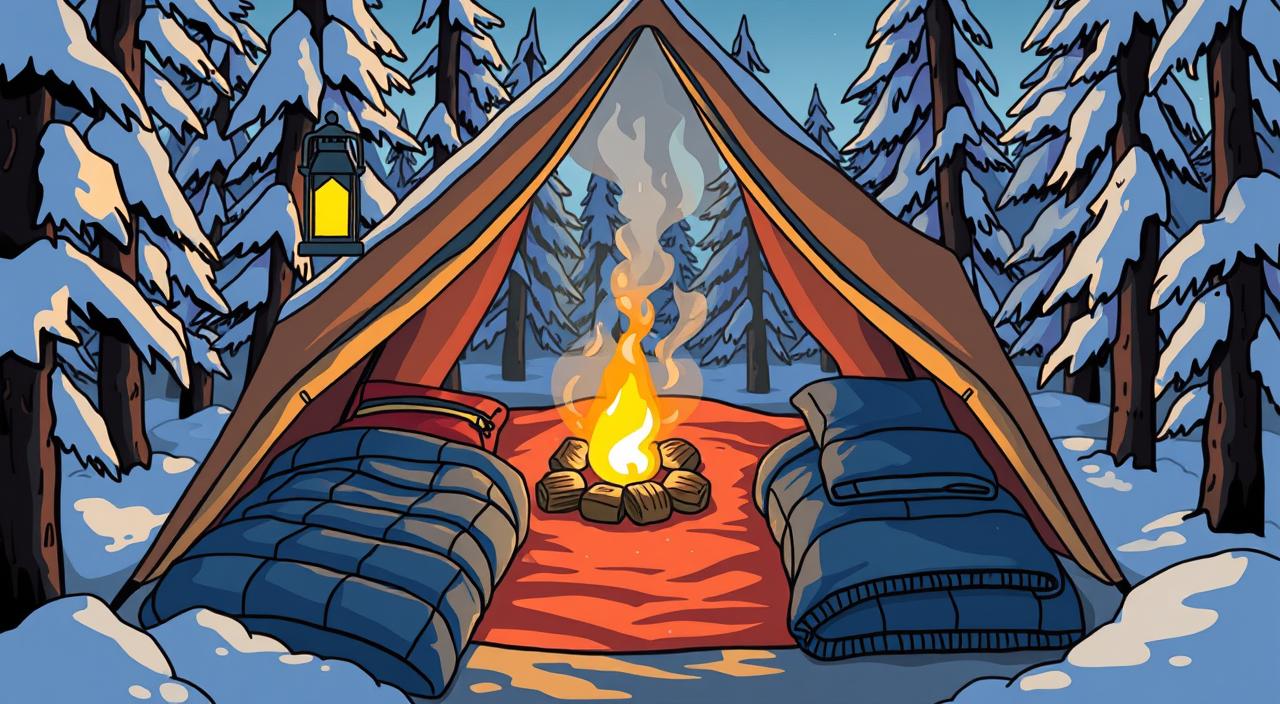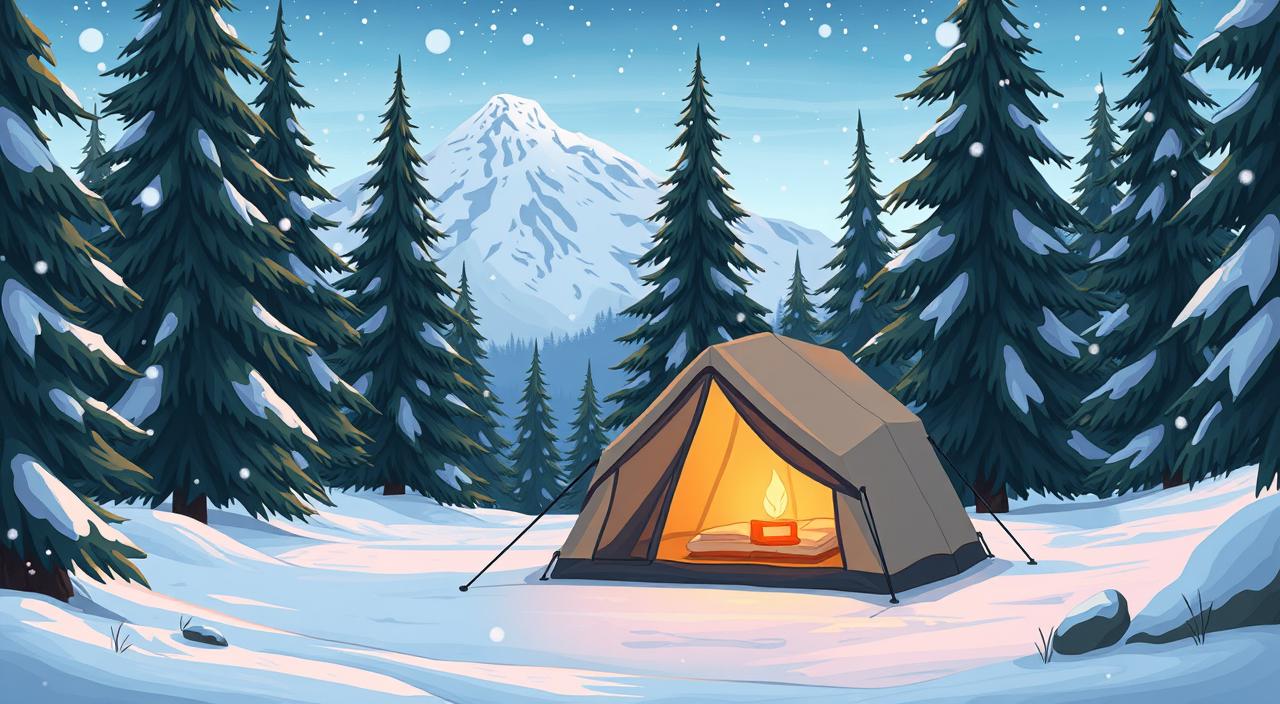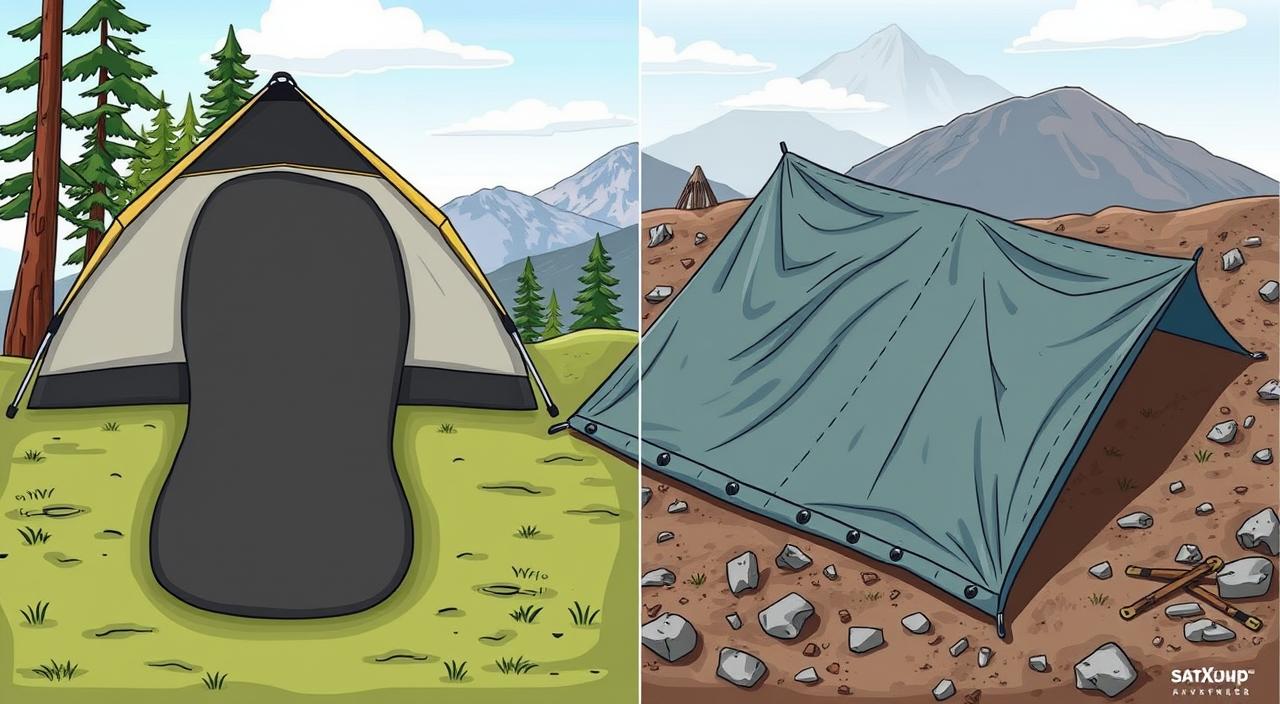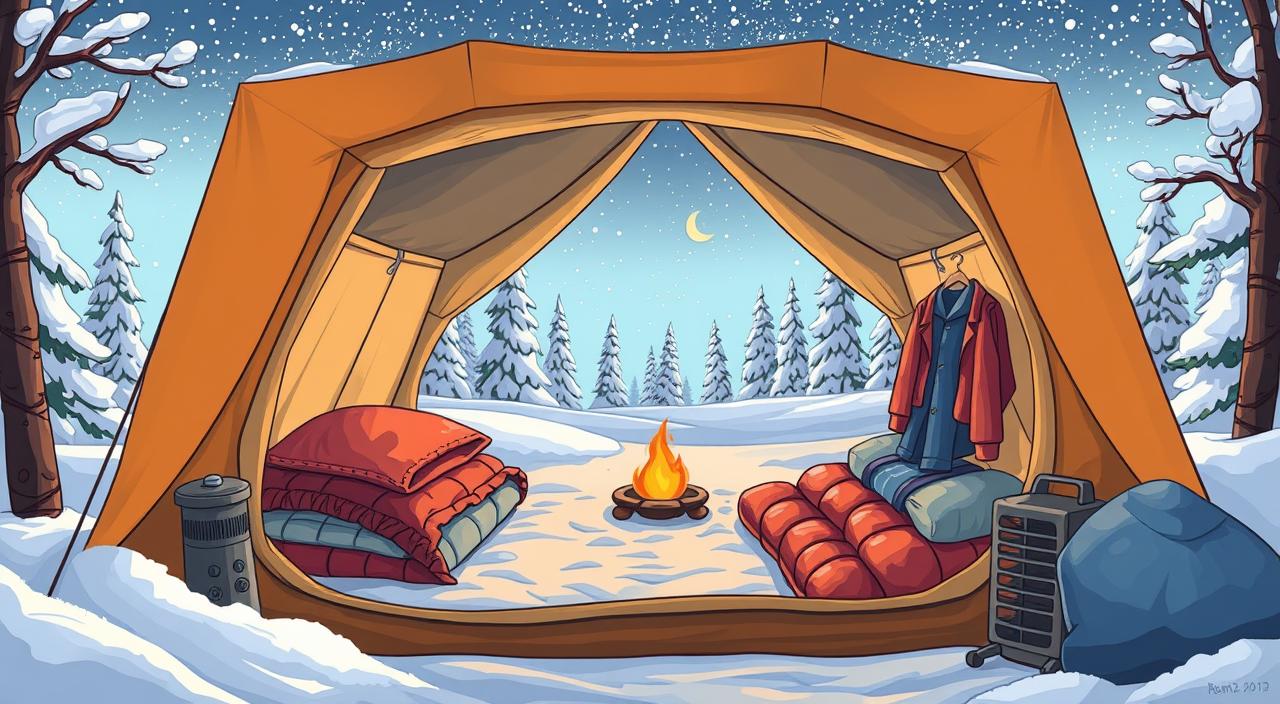
Disclaimer: This post may contain affiliate links. As an Amazon Associate, we earn from qualifying purchases.
Ever found yourself shivering inside your tent, wondering how to keep warm? Staying warm in a tent during winter camping doesn’t have to be hard. With the right techniques and materials, you can make your camping cozy. This article will share expert tips to keep you warm, even in the coldest weather, making your winter adventures enjoyable.
Key Takeaways
- Understanding the importance of proper tent insulation can greatly enhance your camping experience.
- Brands like Mountain Hardwear and The North Face offer reliable four-season tents suitable for winter conditions.
- Adding a thermal blanket inside your tent can reflect body heat and keep you warmer.
- Utilizing a safe tent heater along with insulated sleeping pads ensures maximum warmth.
- Wearing thermal layers and using sleeping bag liners can significantly improve heat retention.
- Good tent site selection can improve heat retention and overall comfort.
- Preparing cold-weather meals in advance can make your winter camping more enjoyable.
Understanding the Importance of Tent Insulation
Tent insulation is key to staying warm while camping in the winter. Cold air and body heat create moisture, which can be harmful to those with asthma or allergies. Without enough insulation, your tent can get damp and cold, making it hard to sleep.
Choosing the right gear is crucial for winter camping. Look for four-season tents, insulated pop-up tents, or tents with AC for the best protection against the cold. These tents often have reflective coatings to keep you warm by reflecting heat back into the tent.
Where you set up your tent is also important. Camping near trees can block wind and snow, keeping you warmer. Adding insulation like a snow wall or using insulating footprints can also make your tent cozier.
There are many ways to insulate your tent floor. You can use foam pads, thin mats, or even natural materials like dried leaves and hay. Lining the roof and walls with insulating fabric or using heat-reflective materials can also help keep heat in. Make sure to seal your tent’s seams to stop drafts and moisture.
Choosing a smaller tent can also help keep more heat inside. Being prepared and knowing how to insulate your tent can make winter camping enjoyable. You’ll be able to enjoy the outdoors without feeling cold or uncomfortable.
How to Insulate a Tent for Cold Weather
Insulating your tent for cold weather means using the right techniques and materials. Start by getting a four-season tent. These tents are built tough and keep the cold out well.
Layering your sleeping gear is key for warmth. Choose a mummy sleeping bag rated for sub-zero temperatures. Make sure it’s filled with ethically sourced down for the best insulation. Add a SkyPad sleeping mat with an R-value of 4.4 for extra warmth.
Adding a thermal blanket on top of your tent is a great tip for winter camping. It helps keep warmth in. Also, insulating the tent floor is important. Use foam padding under your sleeping bag to block cold from the ground.
For more heat, try using heat packs or hot water bottles in your sleeping bag. This adds localized warmth to fight off the chill. Using foil thermal blankets can also help keep the cold out.
Don’t forget about ventilation. You need to keep the air fresh while trapping heat. Close all openings when it’s cold but make sure there’s airflow to prevent moisture buildup. Insulating your tent well is key to enjoying warm nights under the stars, even in cold weather.
Choosing the Right Materials for Tent Insulation
Choosing the right tent insulation is key for staying warm on camping trips. The insulation you pick greatly affects how well your tent keeps heat in, especially in the cold. Knowing your options helps make your tent cozy.
Insulating Fabrics and Options
For insulating fabrics, think about using fleece, wool, or down. These materials are great at keeping heat in, perfect for cold weather camping. A well-insulated tent floor is also crucial; foam padding can block cold air from rising from the ground.
In very cold places, using insulated fabrics or tent heaters can add more warmth. This ensures you stay cozy all night.
Importance of Thermal Blankets
Thermal blankets are a great addition to your tent’s insulation. They reflect and trap your body heat, adding an extra layer of warmth. They’re also light and easy to pack, making them a smart choice for camping.
Layering your clothes and using thermal blankets helps keep you warm. In the cold, picking the right insulation is key for a good camping trip.
Maximizing Tent Warmth with Proper Setup
Getting your tent warm isn’t just about good insulation. The way you set up your campsite is key to staying warm. By picking the right spot and using smart techniques, you can stay cozy, even when it’s freezing.
Site Selection for Optimal Heat Retention
Finding the perfect spot for your tent is vital for staying warm. Look for places with natural barriers like trees or hills that block the wind. Stay away from low spots where cold air can gather. Instead, choose slightly higher ground to keep warm and protect your tent from the cold.
Using a Tarp for Extra Insulation
Using a tarp under your tent is a great way to stay warm. It acts as a shield against the cold ground, keeping your tent cozy. You can also cover your tent with a tarp on top for even more insulation. This simple trick can make a big difference in how warm you stay while camping.
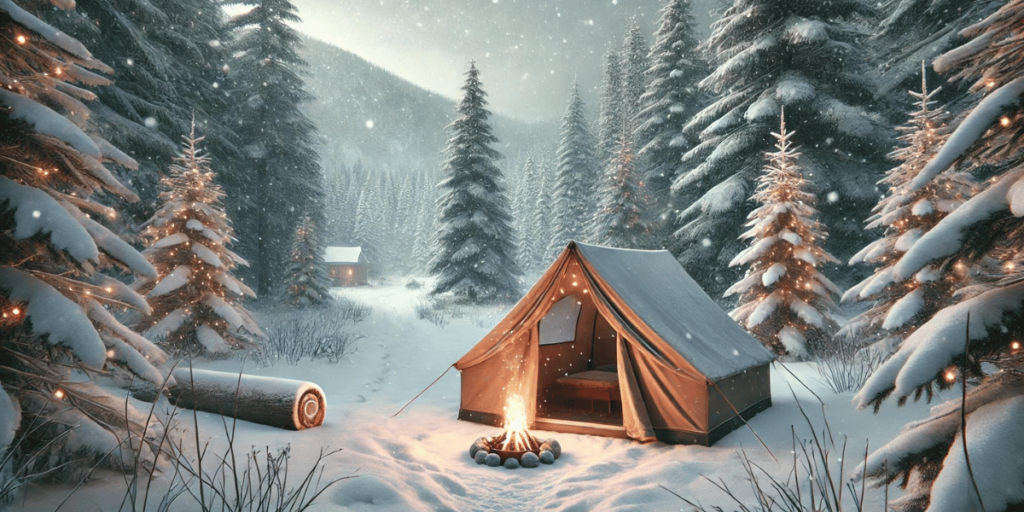
Insulation Techniques to Keep You Cozy
Staying warm in your tent is key. Using effective insulation is crucial. Strategies like using sleeping pads and hot water bottles help keep you cozy in the cold.
Effective Use of Sleeping Pads
High-quality sleeping pads with a good R-value are essential. The R-value shows how well a pad keeps you warm. Choose pads made for cold weather to stay warm.
Using more than one pad or layering them can also help. This makes your sleeping area more comfortable.
Hot Water Bottles as Makeshift Heaters
Hot water bottles are great for keeping warm at night. Fill them with hot water and put them near your sleeping bag. This trick can make you feel cozy and refreshed in the morning.
| Insulation Method | Description | Best Use Case |
|---|---|---|
| Sleeping Pads | Foam or air pads with high R-value that retain heat | Cold weather camping on the ground |
| Hot Water Bottles | Bottles filled with hot water for added warmth | Nighttime heat retention in sleeping bags |
| Insulated Bottles | Keep liquids hot and prevent cold from seeping | Staying hydrated without losing warmth |
| Thermal Blankets | Specialized blankets that reflect body heat | Draping over sleeping bags or lining tent walls |
Using these methods can greatly improve your tent’s warmth. With the right tools and preparation, you can enjoy a warm and restful night outside.
Insulating Tent Walls for Added Warmth
Keeping your tent warm is key. Start by layering blankets to block the cold. Mylar blankets are great because they reflect heat back to you. Using the right methods can greatly improve your winter camping.
Layering Up with Additional Blankets
Layering blankets is essential for insulating your tent walls. You can hang extra blankets around your sleeping area and hold them in place with clamps. You might need:
- 2 blankets for small tents
- 4 blankets for larger tents
Use small green clamps to keep a blanket around each tent pole. They cost about $0.37 each. For bigger areas, use red clamps, priced around $2 each. These layers create a warm barrier for the night.
Using Mylar Blankets for Heat Reflection
Mylar blankets, measuring 5′ by 7′, can change the game for insulating your tent. They cost between $10 to $15 each. Hang them inside to reflect your body heat back to you, making nights warmer.
Putting insulating blankets between the tent wall and the rainfly is smart. It keeps the warmth in and protects against wind. Covering three sides of your tent with Mylar blankets boosts heat retention.
Secure these layers with clamps for a tight fit. Make sure there are no gaps for better insulation. Keep your receipt for any unused items for future adjustments.
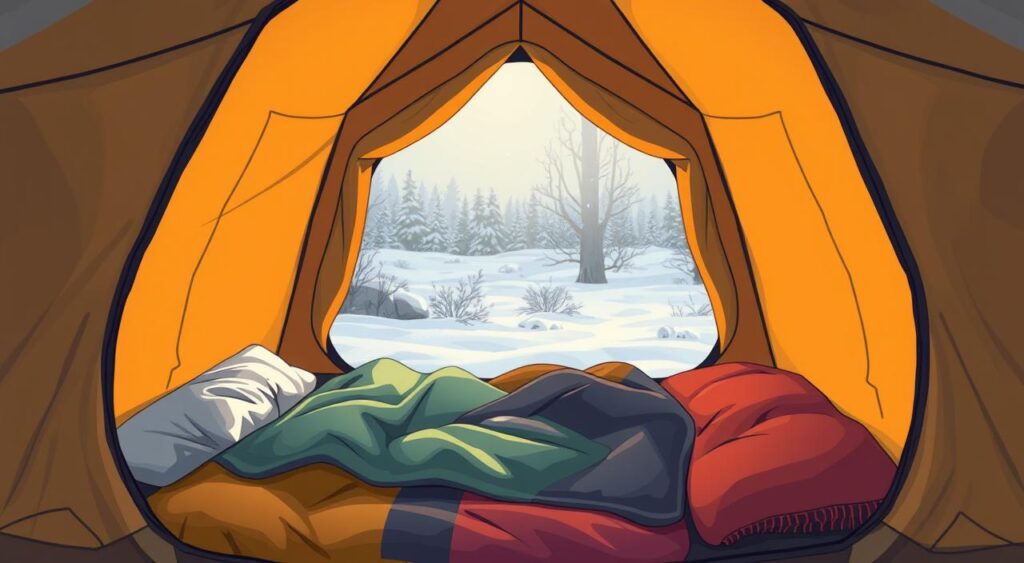
DIY Tent Insulation Hacks on a Budget
Insulating your tent doesn’t have to be expensive. With some creativity, you can use items you already have or find in nature. These budget-friendly ideas will help keep you warm without emptying your wallet.
Repurposing Household Items
Don’t spend a lot on special insulation. Look around your home for items that can insulate well. Here are some options:
- Old blankets: Use them to layer over or inside your tent to keep warm.
- Foam pads: Add these under your sleeping bags for extra cushion and insulation.
- Rugs or large towels: These can protect you from the cold ground.
- Thermal blankets: Great for retaining heat and layering over your gear.
Using Natural Elements for Insulation
Nature has many ways to help insulate your tent. Use these natural materials for better insulation:
- Pine boughs: Use them to block wind and keep heat in around your tent.
- Leaves: Add layers of fallen leaves at your tent’s base for better insulation.
- Snow walls: Build walls with snow around your tent to fight wind chill.
With these budget-friendly ideas, you can stay warm and cozy on your camping trips. Show off your creativity and make your outdoor experience better with every little trick.
Staying Warm in a Tent Without Electricity
Staying warm in a tent without electricity is key for a good camping trip. You should layer your clothes and your sleeping setup. Using insulated sleeping bags helps a lot. It’s best to wear dry and warm clothes to bed to keep heat in.
Your body makes about 100 watts of heat, which you can use with tools like a Mylar space blanket. This blanket reflects your body heat, making the tent warm and cozy. Sharing sleeping bags is also popular and keeps everyone warm, especially kids.
It’s important to manage the air in your tent to avoid dampness. Open a vent a bit to let moist air out without losing warmth. Eating a hot, high-calorie dinner before bed also helps keep you warm.
Hot water bottles are a classic camping item for staying warm. If you don’t have one, use a strong container with warm water. It’s a great way to warm up in your sleeping bag.
Hand and feet warmers can add extra warmth while you sleep. These small devices make heat through oxidation and can keep you warm for hours. They’re a must-have for cold nights.
| Method | Description |
|---|---|
| Insulated Sleeping Bags | Keep body heat trapped and provide additional warmth. |
| Layering Clothing | Wearing dry, warm layers helps regulate body temperature. |
| Mylar Space Blankets | Reflect body heat back into the tent. |
| Hot Water Bottles | Heat sleeping area before bed. |
| Ventilation Management | Prevent moisture buildup to avoid feeling cold. |
| High-Calorie Dinners | Increase body temperature before sleeping. |
| Shared Sleeping Bags | Help maintain warmth during the night. |
| Hand/Feet Warmers | Small devices providing heat through oxidation. |
Using these tips will help you stay warm in a tent without electricity. This makes camping more enjoyable and comfortable.
Winter Camping Tent Insulation Tips
Winter camping needs careful planning to keep your tent warm and cozy. Using the right insulation can make your trip better. Start by picking a sleeping pad with a high R-value, like the SkyPad sleeping mat with an R-value of 4.4. This keeps you warm inside your tent.
Also, layer your blankets and sleeping gear for extra warmth. The Inner Quilt for Connect models has an R-value of 2.7, adding needed insulation. For the best warmth, use mummy sleeping bags with drawstring hoods to keep your body heat in. Ethically sourced down-filled sleeping bags are great for very cold weather.
Protecting your tent from the cold is key. Use ground insulation with tent footprints or insulated foam sleeping pads to keep out the cold. Set up windbreaks with natural barriers to protect your tent from icy winds.
To add more insulation, put thermal blankets between the insect mesh and rainfly. This reflects your body heat back into the tent. Tentsile’s rainfly, with a waterproof quality of 3000 HH for Lite and 5000HH for Classic, keeps moisture out and helps retain heat.
Heat packs inside sleeping bags are a great way to stay warm. Place them next to your body but keep them away from your skin. Hot water bottles are also a good way to warm your sleeping bag before sleeping.
The gear you choose affects how warm you stay. Opt for four-season tents made for winter, offering great insulation and waterproofing. Brands like Mountain Hardwear, NEMO, and Hilleberg are reliable choices. Small tents are better at keeping heat in, so consider this when picking your gear.
| Gear | Details |
|---|---|
| SkyPad Sleeping Mat | R-value of 4.4, excellent thermal resistance |
| Inner Quilt (Connect models) | R-value of 2.7 for additional insulation |
| Tentsile Rainfly | Waterproof quality of 3000 HH (Lite) and 5000 HH (Classic) |
| Mummy Sleeping Bag | Effective heat retention with a drawstring hood |
| Heat Packs | Provides vital warmth inside sleeping bags |
Follow these tips for a warm winter camping trip. Plan ahead, pick the right gear, and use the best techniques to stay warm on your adventure.
Safety Considerations for Insulating Tents
When insulating your tent for winter camping, safety comes first. Knowing how to keep your tent safe can prevent accidents and make your trip better. One big worry is fire hazards. Make sure any portable heaters, like the Mr. Buddy Heater, are safe for inside use and follow the safety rules. Always make sure there’s enough air flow to stop harmful carbon monoxide from building up.
Choose non-toxic insulation materials to keep the air in your tent clean. For example, using reflective foil helps keep warmth in and is safe for you. Make sure any heating packs, like those you can warm up in the microwave or ThermaCare Heatwraps, are okay for what you plan to do. Keep an emergency kit ready with things like a first aid kit, extra blankets, and ways to call for help if something unexpected happens.
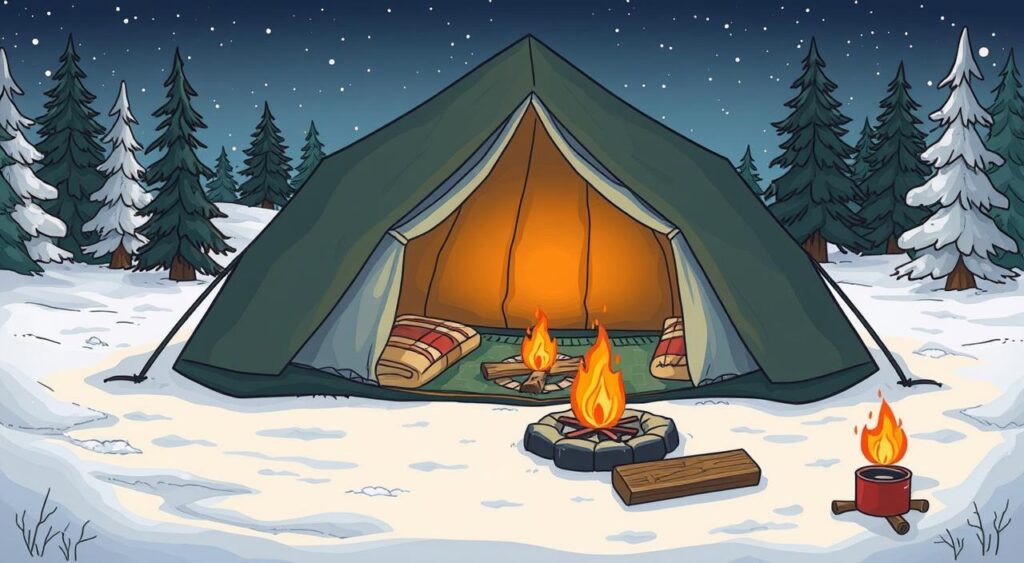
Following these safety tips for insulating tents makes you more comfortable and could save your life. For more tips on keeping warm and safe while camping, check out this resource. It has great advice for winter camping.
| Safety Concern | Recommendations |
|---|---|
| Fire Hazards | Use approved indoor heaters with proper ventilation |
| Material Safety | Choose non-toxic insulation materials |
| Heating Packs | Opt for safe, approved heating packs |
| Emergency Preparedness | Maintain an emergency kit with essential supplies |
Conclusion
Insulating your tent is key to staying warm and comfy while camping in winter. Many campers struggle with the cold, making insulation a top priority. It’s important to know how to insulate your tent with the right materials for the best results.
Using techniques like foam insulation and reflective foil can make a big difference. Layering fabrics correctly also helps keep you warm. These steps can make your camping trips much more enjoyable.
But it’s not just about the materials. Where you set up your tent is also crucial. Look for a spot that protects you from the wind to keep the heat in. Adding extra insulation, like waterproof covers and warm blankets, can also make your tent cozier.
You can find great tips online for making your tent warm and cozy. These strategies can turn your tent into a warm haven even in the cold.
Improving your tent’s insulation not only keeps you warm but also makes winter camping better. You can either buy an insulated tent or try DIY methods to save money. Being well-prepared lets you enjoy the winter outdoors without the cold bothering you.



